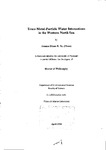Trace Metal-Particle Water Interactions in the Western North Sea
| dc.contributor.author | Dixon, Joanna | |
| dc.contributor.other | School of Geography, Earth and Environmental Sciences | en_US |
| dc.date.accessioned | 2013-09-19T13:31:44Z | |
| dc.date.available | 2013-09-19T13:31:44Z | |
| dc.date.issued | 1998 | |
| dc.identifier | NOT AVAILABLE | en_US |
| dc.identifier.uri | http://hdl.handle.net/10026.1/1894 | |
| dc.description.abstract |
The distribution of trace metals (Fe, Mn, Cu, Cd and Pb) has been determined in dissolved and particulate phases, along with relevant hydrographic parameters, from the nearshore coastal zone of the western North Sea (between 52ON and 56ON) during four Land Ocean Interaction Study (LOIS) surveys covering the seasonal cycle (autumn 1994 to summer 1995) The behaviour of the redox-sensitive metals, Fep and Mnp in the western North Sea were strongly correlated (r>0 44 for all seasons, P<0 05) in all surveys and exhibited maximum concentrations in winter (16 mg g -1 and 700 ug g-1 respectively) which progressively decreased throughout the year Distinct seasonal variations were also observed for particulate Cu, Cd and Pb For example, enhanced concentrations of Cup (36 ± 39 ug g-1) and Cdp (0.36 ± 0.42 ug g -1) in the Humber coastal zone during summer were attributed to preferential particulate organic/biogenic-metal interactions. In contrast enhanced, though diffuse, atmospheric inputs of Pb from continental winds were considered to have contributed to the elevated Pbp concentrations (82 ± 27 ug g -1) observed offshore during winter Results from radiotracer incubation experiments suggest that biological activity makes a significant contribution to the removal of dissolved Mn and Cd to the particulate phase. However, a phase lag of two to three months between maximum primary productivity and maximum particulate metal adsorption (KD=2 X 104 & 5 x 102 for Mn and Cd respectively) indicates a decoupling from the spring plankton bloom In general metal distributions in the Humber coastal zone were significantly influenced by freshwater discharge, tidal regime at the mouth of the estuary and prevailing wind conditions Total trace metal fluxes across the mouth of the Humber Estuary were highest during spring (311, 8 96 & 1045 kg day-1, for Cu, Cd and Pb respectively) and lowest during summer (25 7, 1 .12 & 33 4 kg day-1, for Cu, Cd and Pb respectively) They were dominated by variations in freshwater outflow and the tidal range during sampling On an annual basis comparison to estuarine inputs (rivers, industry and sewage sources) suggested retention of Cu (25%) and Cd (56%) Estimates of partitioning (KD) were derived from the dissolved and particulate data for Cu, Cd and Pb over the seasonal cycle Copper was dominated by the particulate phase (73-80%) in all seasons but summer, whilst Cd showed particulate phase dominance (54-70%) in autumn and winter only The Pb distributions were dominated by the particulate phase (94-99%) independent of season Trace metal settling velocities implied that the Humber Plume was acting as a sink for Cu, Cd and Pb in winter and spring However settling velocities calculated for Cd and Pb (flood tide) in summer were similar to background suspended particulate matter (SPM) suggesting long range transport with the residual circulation. Modelling of Pb isotopic ratios in the Humber Plume suggested that on average 32-39% of the extracted Pbp originated from anthropogenic sources The data from this study has given unique information concerning the concurrent seasonal distributions of particulate trace metals in the western North Sea and have yielded new insights into mechanisms affecting trace metal cycling and transport, essential in the development and refinement of coupled hydrodynamic-geochemical models. | en_US |
| dc.description.sponsorship | Plymouth Marine Laboratory | en_US |
| dc.language.iso | en | en_US |
| dc.publisher | University of Plymouth | en_US |
| dc.title | Trace Metal-Particle Water Interactions in the Western North Sea | en_US |
| dc.type | Thesis | |
| plymouth.version | Full version | en_US |
| dc.identifier.doi | http://dx.doi.org/10.24382/3823 | |
| dc.identifier.doi | http://dx.doi.org/10.24382/3823 |
Files in this item
This item appears in the following Collection(s)
-
01 Research Theses Main Collection
Research Theses Main


